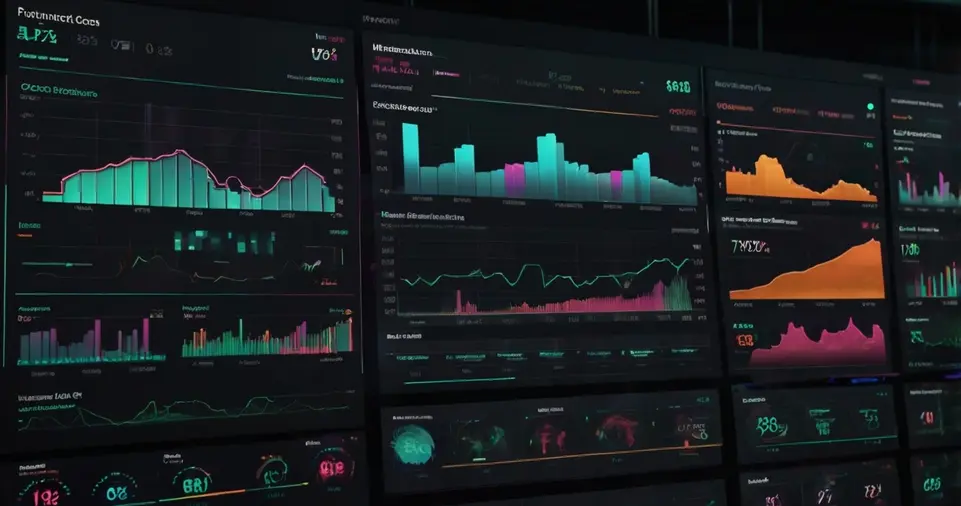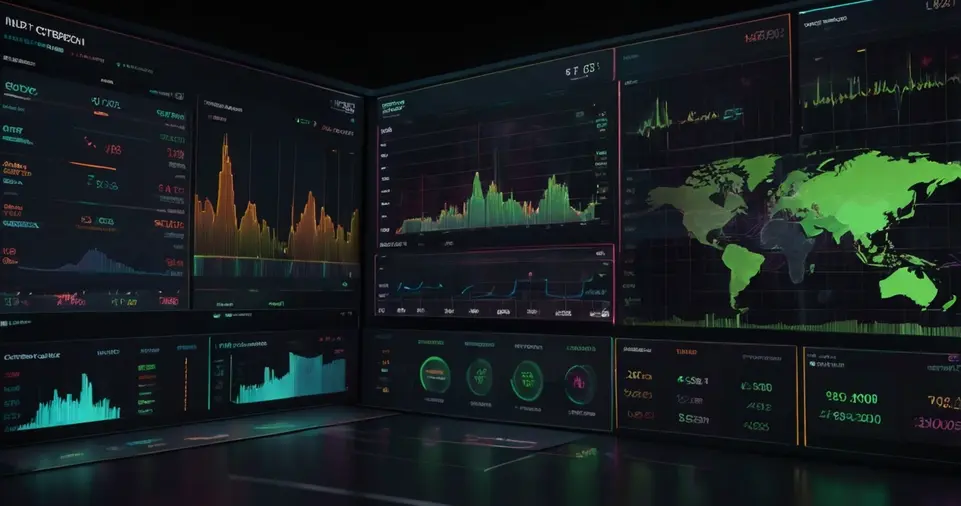Cryptocurrency has evolved from an obscure investment niche to a major player in global finance.
As more individuals enter the world of digital currencies, managing and tracking crypto portfolios has become increasingly important.
With the volatility of the market and the complexity of tracking a variety of assets across multiple exchanges and wallets, it’s essential to stay organized and up to date on your holdings.
For those who are new to the space, the process can seem overwhelming, but with the right tools and strategies, you can manage your portfolio like a seasoned investor.
Tracking your crypto portfolio goes beyond simply knowing how much profit or loss you’ve made.
It involves understanding the broader market, keeping tabs on each asset’s performance, and having a clear view of your overall investment strategy.
By using the right technology and adopting a structured approach, you can make informed decisions, optimize your portfolio for risk and return, and streamline your investing efforts.
In this guide, we’ll walk you through the tools, strategies, and best practices that will help you become a pro at tracking your crypto portfolio.
Why Tracking Your Crypto Portfolio Is Essential
The volatile nature of cryptocurrencies means that prices can fluctuate wildly in a short period of time.
Without effective tracking, you could miss out on major price movements, which could result in missed opportunities or significant losses.
Regular tracking ensures that you’re always aware of your investments’ performance, helping you make informed decisions on whether to buy, sell, or hold your assets.
Tracking your portfolio isn’t just about keeping an eye on prices, though. It also involves keeping a record of your transactions for tax purposes.
The tax implications of crypto investments can be complex, especially as regulations vary by country.
Accurate tracking can help you avoid costly errors during tax season and ensure compliance with local laws.
By organizing your portfolio and recording every transaction, you ensure that your financials are in order, which will save you time and effort when tax season arrives.
In short, proper portfolio tracking offers more than just peace of mind—it’s a crucial aspect of managing risk, optimizing returns, and ensuring compliance.
Without effective tracking, you could easily find yourself lost in a sea of transactions and fluctuating prices, which makes managing a crypto portfolio much more difficult.
The Best Tools to Track Your Crypto Portfolio

In the age of digital assets, numerous tools can help you track and manage your crypto portfolio effectively.
Whether you’re a casual investor or a full-time trader, these tools will simplify your experience and provide the insights you need to make informed decisions.
Let’s dive into the best tools available for portfolio tracking:
Portfolio Tracking Apps
Portfolio tracking apps are one of the most user-friendly solutions for tracking crypto assets.
These apps automatically sync with your wallets and exchanges, making it easy to monitor all your holdings in real time.
Some apps allow you to enter transaction details manually, but most can import data directly from exchanges and wallets.
CoinTracker:
This app offers not just portfolio tracking but also tax reporting capabilities, helping you maintain accurate records for tax season.
It integrates with numerous exchanges and wallets and provides a comprehensive view of your portfolio’s performance.
Delta:
Delta allows you to track the performance of your crypto portfolio across multiple exchanges and wallets.
It also provides detailed charts and alerts, making it easy to keep track of price movements and market trends.
Blockfolio (now part of FTX):
A popular app among crypto traders, Blockfolio offers portfolio tracking with live price updates and detailed asset analysis. It also supports a wide range of exchanges and cryptocurrencies.
Zapper:
A favorite for decentralized finance (DeFi) users, Zapper aggregates data from DeFi protocols, allowing users to track their investments across multiple platforms. It’s perfect for those who have ventured into DeFi, NFTs, and liquidity pools.
Exchange-based Portfolio Trackers
Many cryptocurrency exchanges offer their own portfolio tracking tools, often integrated into their trading platforms.
These tools can be convenient if you primarily trade on one or two exchanges, as they consolidate all your holdings in one place.
Binance:
Binance offers portfolio tracking tools that allow you to monitor all your investments across different pairs and tokens.
It provides real-time data on your portfolio’s performance, making it easy to stay on top of your holdings.
Coinbase:
Coinbase’s portfolio tracker offers a simple interface for managing crypto holdings. It displays the value of your portfolio, including transaction history and trade details, all in one place.
Although exchange-based portfolio trackers are convenient, they often lack the advanced features of dedicated tracking apps. They’re ideal for users who prefer to keep their investments centralized in one place.
ALSO READ: How to Understand and Use Decentralized Finance (DeFi) Tools
How to Organize Your Crypto Portfolio for Maximum Efficiency

Effective portfolio organization is essential for monitoring performance and managing risk.
Whether you hold a single asset or a diverse collection of tokens, having a clear structure helps you make better decisions.
Here’s how to organize your crypto portfolio efficiently:
Diversify Your Portfolio
Just like traditional investments, diversification is crucial for mitigating risk in your crypto portfolio.
Having exposure to a variety of assets—including Bitcoin, Ethereum, altcoins, and tokens from different sectors—helps protect your portfolio from the volatility of any single asset.
Be sure to allocate your assets based on your risk tolerance, with a portion of your portfolio dedicated to safer, more established coins and another portion reserved for higher-risk altcoins.
Categorize Your Assets
Categorizing your assets can help you track performance and understand how each segment of your portfolio is performing.
You can categorize your assets based on factors such as:
- Type of Asset: Segregate your holdings by categories like Bitcoin, altcoins, DeFi tokens, NFTs, and stablecoins.
- Risk Level: Divide your assets into high-risk, medium-risk, and low-risk categories. This helps you understand how much risk you’re willing to take on in different areas.
- Long-term vs Short-term: Separate your holdings into long-term investments and short-term trading assets. This will help you make decisions on when to sell or hold based on your goals.
Regularly Review and Rebalance
Tracking isn’t a one-time job—it requires constant attention. Regularly reviewing your portfolio helps you make adjustments based on market trends and changes in your financial goals.
Portfolio rebalancing is crucial to ensure that your asset allocation remains aligned with your risk profile.
Rebalancing involves selling assets that have performed well to maintain your target allocation and buying underperforming assets to capitalize on potential growth.
Setting Alerts and Notifications for Price Movements
Price alerts and notifications are essential for staying on top of your portfolio. Setting up alerts ensures that you never miss important market movements, even if you’re not actively monitoring your investments.
Many tracking apps and exchanges allow you to set price alerts for specific cryptocurrencies, notifying you when they hit a particular price point.
These alerts can help you capitalize on favorable market conditions and avoid major losses when prices move in unfavorable directions.
Be sure to set alerts for your buy and sell targets, and use stop-loss orders when possible to automatically sell if prices drop below a certain threshold.
Tracking Your Portfolio for Tax Purposes
Tax compliance is an often-overlooked aspect of crypto investing. Since cryptocurrency is considered property in many countries, each transaction—including buying, selling, and exchanging tokens—may have tax implications.
Without proper tracking, it can be difficult to calculate your gains and losses, which could lead to tax penalties or missed deductions.
Using a portfolio tracking tool that integrates tax reporting features can help you generate detailed reports for your tax filings.
Tools like CoinTracker and Koinly automatically track your transactions and generate tax reports, making the process less stressful when tax season arrives.
Ensure that you keep detailed records of all your crypto transactions, including the date of purchase, the amount spent, the price at the time of purchase, and any associated fees. This will help ensure that your tax filings are accurate and up to date.
Staying Informed: News and Market Trends
To make informed decisions about your crypto investments, it’s essential to stay updated on market news and trends.
The crypto market is influenced by many external factors, including regulatory changes, technological advancements, and macroeconomic events.
Keeping track of these developments can provide valuable insights into where the market is headed and help you make better decisions about your portfolio.
You can follow industry news through platforms like CoinDesk, CoinTelegraph, and The Block, or use aggregator tools like CryptoPanic to stay informed on breaking news.
Additionally, subscribing to podcasts and newsletters from reputable crypto analysts can provide deeper insights into the market.
ALSO READ: How to Make Money with Crypto Without Investing (Staking, Airdrops, etc)
Conclusion: Mastering Crypto Portfolio Tracking
Tracking your crypto portfolio like a pro requires the right tools, strategies, and a disciplined approach.
By using portfolio tracking apps, diversifying your holdings, and setting alerts, you can ensure that you stay on top of market fluctuations and make informed decisions.
Regularly reviewing and rebalancing your portfolio will help you optimize your investments, while using tax reporting tools ensures you remain compliant with local regulations.
By incorporating these strategies into your crypto investment routine, you’ll be better equipped to navigate the volatility of the market and achieve long-term success.
Whether you’re just starting or you’re an experienced trader, effective portfolio tracking is a key component of mastering the crypto game.











